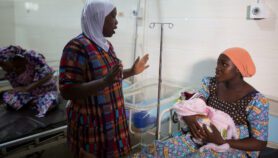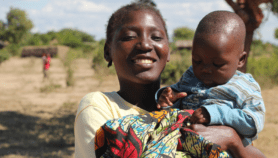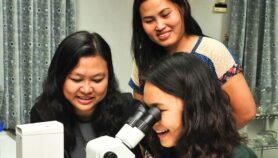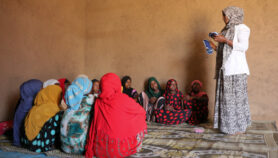Send to a friend
The details you provide on this page will not be used to send unsolicited email, and will not be sold to a 3rd party. See privacy policy.
We are far from easing the drudgery of women farm workers. But there is growing interest in designing technologies to improve their lives, report M Sreelata and Naomi Antony.
The seemingly simple act of removing the husks from maize cobs by hand is tougher than it sounds. A female worker uses her fingertips on average 522 times, her fingernails 144 times and her palms 55 times for every single kilogram of grain she produces, according to a survey carried out last year by India’s Ministry of Agriculture.
Women — whether young or old, healthy or sick — can be found across the developing world working long hours without rest. They pick tea, process tobacco, shell cotton pods, spread fertilisers on fields and transplant rice.
In the developed world, this work is usually done by machines. But in poor countries, much of the labour is done by hand — and a woman’s hand at that.
"It’s shameful," says Anil Gupta, executive vice-chair of India’s National Innovation Foundation (NIF).
"India can send up ten satellites in a single launch in different orbits. The science and technology capacity that we have is enormous. And yet when it comes to problems that women face, there’s a huge silence, there is a huge indifference."
The invisible workforce
The drudgery of women’s work in agriculture, its impact on their education, food security, health and productivity, and the potential role of technology in reducing its effects, were the focus of an international conference in New Delhi in March 2012.
The meeting was organised by the Global Forum on Agricultural Research (GFAR), the Indian Council of Agricultural Research, and the Asia-Pacific Association of Agricultural Research Institutions.
More than 700 participants from 50 countries attended the meeting, which took place in the context of two reports on the role of women in agriculture — one in 2010 from the UN’s Food and Agriculture Organisation, and the other from the World Bank, released in 2011.
The UN report estimates that women contribute 47 per cent of global agricultural labour. But this international average is misleading. In many countries it is far higher; in Lesotho, Mozambique and Sierra Leone, for example, women carry more than 60 per cent of the agricultural workload. In Egypt women make up less than half of the agricultural workforce but account for 85 per cent of unpaid farm labour.
The nature of women’s manual labour has changed little in many developing countries for centuries, either because technologies and innovations haven’t catered to their particular needs, or because they are inaccessible or unaffordable.
Part of the problem, according to Ebba Augustin, chief executive officer of Saaned – an Egypt-based non-government organisation (NGO) – is that female agricultural labourers are an "invisible" workforce who see farm work as an extension of their family role, or are seen by others as unpaid assistants to their husbands.
So part of the challenge of tackling the agricultural drudgery endured by women is in changing ingrained cultural attitudes. For example, says Gupta, women are often denied access to equipment, such as blacksmith and carpentry tools, which would make their work easier and less physically taxing. "The rate of technological change in the tasks that men perform has been much faster," he says.

Researchers need to understand the pains and needs of women workers, say critics
Flickr/seemakk
Gender-friendly tools
Given the male-bias of tool-use, the Delhi conference heard of the need to tailor technologies to meet the needs of female agricultural workers — and to make them cheap enough for women to access.
These could include farm machines that take account of the different needs and capacities of women’s bodies, catering to their typically lower mass and muscle strength, postural differences, load-bearing and lung-breathing capacity, and oxygen consumption rates.
"The performance of a tool or [piece of] equipment not only depends on the constructional features, but also on the workers operating it," says Pitam Chandra, director of the Central Institute of Agricultural Engineering (CIAE), India.
But research in this area has been limited and, the conference heard, fragmented rather than systematic.
In India, where nearly half the country’s 241 million agricultural workers are women, the NIF recently announced it would give a one-million rupee award to anyone who could design a device to reduce the drudgery of women who pluck tea leaves and transplant rice.
So far, Gupta says, there have been no winners.
And even where the research is promising, the results have often failed to spread from research institutes to the fields in which women work.
Researchers need to understand "the pains and needs of women workers", says Wais Kabir, executive chairman of the Bangladesh Agricultural Research Council (BARC).
He points out that scientists at BARC spend extended periods of time visiting villages to meet local farmers before designing products with women workers in mind.
And mass-producing products at an affordable price for women farm workers isn’t easy. Chandra told the conference that the CIAE has collected data on the physical stature of Indian male and female farm workers to guide the development of improved, gender-friendly tools. He says since 1996 the centre has pioneered around 25 women-targeted innovations.
Less than half of these, however, have reached the women they were designed for. "There have been some successes," Chandra says. "A few hundred thousand gender-friendly tools and machines are in use. However, this is a drop in [the] ocean."
An improved CIAE-designed sickle that reduces drudgery by 16 per cent is still in prototype form. So too are other designs for paddy-seeders, weeders, and suspended cleaners that allow workers to remove dirt and stones from grain without having to bend over for hours.



An improved version of a sickle that reduces drudgery by 16 per cent is still in prototype form
Flickr/net_efekt
Even when a new piece of machinery or equipment does make the journey from laboratory to market, women may not reap the benefits. In cultures where machinery is regarded as the domain of male workers, technologies designed with women users and women’s activities specifically in mind can become "attractive to male workers" because the solution involves machine use, says Chandra.
Marketing issues
Nonetheless, there is growing interest in providing more appropriate machinery and tools for women in India, Chandra told SciDev.Net, partly in response to an acute shortage of farm labour.
The CIAE is now working on a public-private partnership model to establish manufacturing hubs in areas where women-friendly implements and gadgets are in the greatest demand. And Chandra says the government has also begun subsidising their cost to farm workers.
"During the next five years we have a very ambitious plan to take these implements to market and try to give them to women at a lower cost. This is a big job and it will take time for the benefits to be reaped," he says.
In neighbouring Bangladesh, Kabir says greater emphasis is being placed on importing more appropriate machinery and equipment from countries like China, rather than producing it locally, as the potential profits would be too low for local manufacturers.
A second avenue is also being explored through a series of government trials, under which farm extension points supply equipment produced by state-run manufacturers free of charge to women. These include fertiliser applicators, shellers and threshers, all of which have proven popular with women farmers.
But women are not always treated as an important target audience by agricultural extension programmes, which are meant to bridge the gap between the laboratory and the field, Augustin told the New Delhi meeting. In Egypt, for example, agricultural extension messages only target male farmers, she says.
Finally, there is a challenge in ensuring that women are trained to repair and maintain the few products that do reach workers in the fields.
“If urban women can operate machines, there is no reason why rural women should not be encouraged to operate agricultural equipment. It only requires infrastructure and facilities for training them in rural surroundings within their reach,” Chandra said.
Innovating despite obstacles
Given the low priority attached by governments, manufacturers and even NGOs to alleviating female drudgery, progress in tackling the problem has been slow, and there have been occasional reversals.
Augustin cites a 2011 study by the Association of Agricultural Research Institutions in the Near East and North Africa, which found that efforts to introduce gender-friendly machinery in Egypt and Jordan were discontinued after donor support came to an end.
Nonetheless, there have been some notable success stories, says Gupta. He cites the example of Arkhiben Vankar, a midwife from Gujarat state, India, who has become known as ‘the pesticide lady’.
"When women have to use pesticides they often use chemical pesticides, which are harmful to them", Gupta told SciDev.Net. "So, apart from the drudgery, there are also hazards."
Vankar developed a herbal pesticide that reduced costs and was toxin-free. After testing various plant extracts she discovered that some bitter plants can deter pests such as aphids, mealy bugs and white flies. Studies have shown this bio-pesticide to be just as effective as chemical pesticides.
The NIF has identified other inventions by women, including an insecticide based on eucalyptus oil, a herbal growth promoter for tomatoes, a tooth powder (toothpaste in powder form) made from plant latex, and herbal treatments for animal infections.
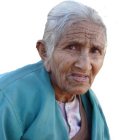


Arkhiben Vankar is known as the ‘pesticide lady’
National Innovation Foundation, India
Other innovations designed by women agricultural workers and documented by the NIF include a bicycle-operated pump for drawing up ground water; an umbrella that doubles as a water sprayer for fields; and a two-in-one stove that simultaneously cooks food and heats water in the home.
Elsewhere in the world, similar grassroots innovations are being encouraged.
A miller-cum-thresher machine is the result of a joint project between the Bill and Melinda Gates Foundation (BMGF) and the UN Development Programme.
The machine is powered by a diesel engine and can also function as a dehusker a battery charger – and generate electricity to power lighting, refrigeration, water pumping, and carpentry and joinery equipment.
It is available to communities in Angola, Burkina Faso and Mali, where women have been taught to build the device themselves, says Haven Ley, senior programme officer at BMGF.
Such devices can carry out traditionally laborious tasks such as dehusking and milling maize, millet, sorghum and other grains, which are normally done using a mortar and pestle or grinding stone. Mechanising these tasks makes them become easier, faster, and potentially more profitable.
An empowered future
At the close of the Delhi conference, GFAR formally announced the Gender in Agriculture Partnership (GAP) which, since its establishment in 2011, has been building and developing collaborations to support women’s needs in relation to agriculture, food and nutrition.
GAP brings together agencies such as the UN Food and Agriculture Organisation, the Consultative Group on International Agricultural Research, the International Fund for Agricultural Development, the UN World Food Programme and the World Bank, as well as regional groupings of national agricultural research and extension systems, NGOs and networks of women farmers and civil society organisations.
"These have already begun to find great value in working together," says GFAR executive secretary Mark Holderness, adding that collaborations are already yielding results in "reviewing how innovation can better serve the needs of women producers around the world, examining differences between men’s and women’s views of priority agricultural needs".
Reducing the drudgery of women agricultural workers is still a goal rather than a clear work in progress. But the conference represents a firm sign of growing interest in not only ending the invisibility of women’s contribution to agriculture, but of eliminating the drudgery that blights the lives of millions of working women in the developing world.
Additional reporting by T. V. Padma.


